
Jaguar, the British luxury automaker, is at a critical crossroads as it navigates its bold transition into the electric vehicle (EV) market. As part of their “Reimagine” strategy, first launched over three years ago, Jaguar plans to go all-electric by 2025. This ambitious goal has led to a decision that shocked many fans—killing off most of their current lineup in favor of building a more exclusive, upmarket brand with a tight focus on three key models. However, the journey hasn’t been smooth, and Jaguar’s struggle to adapt has been evident.
Jaguar’s managing director, Rawdon Glover, candidly expressed frustration about the slow pace of progress during an interview with Top Gear. The company has yet to produce any new vehicles under the Jaguar brand since announcing the “Reimagine” strategy. While the lack of new models is concerning, the bigger challenge lies in the EV shift itself. Building electric vehicles requires different technologies, expertise, and infrastructure than combustion cars.
Also, don’t forget that you can get discounted new car pricing with a free quote through qualified local dealer partners.
Glover pointed out that Jaguar will need “a whole suite of EV services” to compete in the electric market. Beyond simply building electric cars, the company has to create a supporting ecosystem, which includes charging networks, battery technology, and EV-specific customer services. As Jaguar aims to move upmarket and sell fewer but more expensive models, the stakes couldn’t be higher.

Despite these challenges, Jaguar’s first significant step towards its new identity is on the horizon. Later this year, we’ll witness the debut of their electric four-door GT, expected to cost over £100,000 (around $130,755). This flagship model will be built on the new Jaguar Electrified Platform and will be accompanied by two additional electric SUVs in the coming years.
This luxury EV will be Jaguar’s attempt to position itself among prestigious brands like Porsche and Bentley, elevating the automaker into the ultra-premium segment. However, the timing is delicate. Consumer enthusiasm for electric vehicles, even in the high-end market, has started to cool off. The question remains—can Jaguar’s new GT win over affluent buyers and redefine the brand’s future?
Jaguar’s strategy to reduce production volumes while increasing the price point is a high-risk, high-reward move. As the automotive world shifts toward electrification, Jaguar must not only overcome the hurdles of designing and producing cutting-edge EVs but also convince luxury buyers that they can deliver a product worthy of a six-figure price tag. With only three core models in the pipeline, each one needs to be a hit.
The upcoming GT will be a defining moment for Jaguar, serving as a litmus test for how well the brand can transition into the electric age. If successful, it could propel Jaguar into the ranks of elite luxury automakers. But if they stumble, it could mark the beginning of a long struggle to remain relevant in an increasingly competitive EV market.
As 2025 approaches, Jaguar is racing against time to electrify its brand. With so much on the line, all eyes will be on the British automaker as it prepares to launch its new flagship model—and potentially reshape the future of luxury EVs.